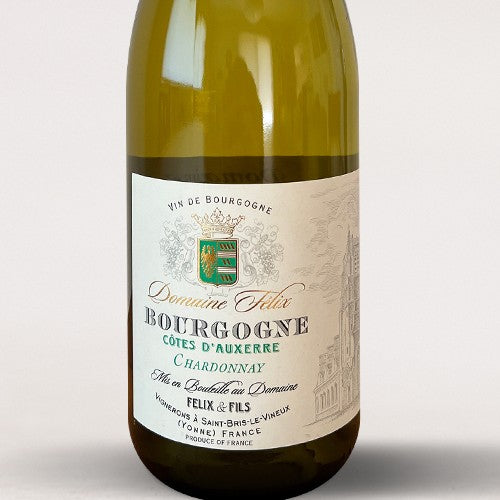What I said about this wine’s red sibling a few months ago is doubly true for this Côtes d'Auxerre Chardonnay: This much Burgundy for this little money is getting rarer than ever. Domaine Félix is one of the most exciting discoveries to come our way in a long, long, time, offering sweet validation to those willing to “think outside the box” about white Burgundy. If the Côtes d'Auxerre is unfamiliar to you, today’s the day to discover a new destination for value in a punishingly pricy region.
This is a lacy, lifted, crunchy Burgundy Chardonnay that could easily be mistaken for something far more pedigreed, but let’s not damn the Côtes d'Auxerre with faint praise—it may be that these northern reaches of the Burgundy AOC are best-positioned for success in a warming climate. No longer an unknown “outer borough,” this is likely to become much more prestigious real estate in the years to come, but in the meantime, let’s all commit highway robbery by scooping up this delicious, invigorating gem. Everything we’ve tasted from this domaine has knocked our socks off; I’m certain you will feel the same.
The Côtes d’Auxerre is a good two hours northwest of Burgundy's heartland, the Côte d’Or. Located in the Yonne River valley, among a cluster of appellations that includes Chablis, Irancy, and Saint-Bris, Côtes d'Auxerre is a spotty patchwork running north-south along rolling hillsides and slopes at varying altitudes. Historically, these sites remained too cold and often produced wines lacking ripeness, with unforgiving acidity. However, these past two decades have witnessed warmer growing seasons year after year despite their long, icy winters. The soils contain the same Kimmeridgian limestone found in Chablis.
Domaine Félix, a family estate dating all the way back to 1690, is headquartered in the village of Saint Bris Le Vineux, about 16 kilometers west of Chablis. The estate’s dimensions remained essentially unchanged for centuries (about 11 hectares of vines), but in the ’90s and 2000s, new acquisitions grew the Félix family holdings to 32 hectares. Their farming methodology is described as lutte raisonée (“reasoned fight”), which calls for organic practices except in emergency circumstances.
Domaine Félix also produces Chablis and Saint-Bris wines, and this Côtes d'Auxerre bottling is a taut, mineral kindred spirit. Fermented and aged in temperature-controlled stainless steel (in the manner of most Chablis), it displays a bright straw-gold core with flashes of silver and green, with textbook cool-climate Chardonnay aromas of green and yellow apple, lemon/lime zest, white flowers, crushed oyster shells, and wet stones. It is medium-bodied and offers some pleasing juiciness on the mid-palate before buttoning up with a wave of acidity and minerality. It certainly will improve over the next few years if you’re so inclined, but at this price, you can afford to grip it and rip it: Decant it 15 minutes before serving in all-purpose stems at 45-50 degrees and let the wine shine alongside some whole grilled fish, prepared simply and drizzled with copious amounts of lemon. If you didn’t know Côtes d’Auxerre before, you’ll never forget it now!











